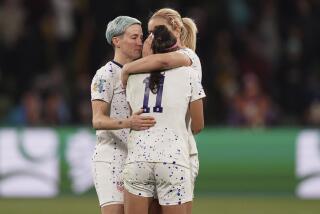U.S. Doubles Team Can’t Get It Done : Tennis: Apell and Bjorkman keep Sweden alive in Davis Cup. Sampras will get first chance to clinch today.
- Share via
GOTHENBURG, Sweden — With the U.S. Davis Cup team holding a 2-0 lead after the first day of singles competition against Sweden, the American doubles team had a chance to clinch the semifinal and send the United States to the Davis Cup final.
But doubles is seldom the place to look for glamour or heroes. Unless they are Swedish. The team of Jan Apell and Jonas Bjorkman easily handled Jared Palmer and Jonathan Stark of the United States on Saturday in front of 3,451 at the Scandinavium arena. The 6-4, 6-4, 3-6, 6-2 victory kept Sweden alive in the best-of-five competition.
“We’re still in the game,” said Jahon-Anders Sjogren, Sweden’s captain. “We have a chance to win, and we will take it. We have to find a way out.”
Pete Sampras plays Stefan Edberg today, followed by Todd Martin against Magnus Larsson. If the U.S. team wins either match, it will play host to Russia for the Davis Cup final in December. Russia would be the host if Sweden wins.
The Swedish doubles team got 71% of its first serves in and, under that pressure, the U.S. players did not start points well. Because the Swedes returned serve so well, the American players were left looking for shots.
“They got jumped on,” U.S. captain Tom Gullikson said. “I don’t think either of those two (Swedish players) could have played better.”
Bjorkman’s performance was no surprise. The 22-year-old lost to Michael Stich in the quarterfinals of the U.S. Open, and many here had expected him to be named as a singles player for Sweden, ahead of Larsson. He said his play was not inspired by a desire to prove he should have played singles, but few believed him.
Saturday, he joined his regular doubles partner, Apell, and their fluency as a pair provided a marked contrast to the U.S. “team” and its hesitancy and indecisiveness.
Stark and Palmer were doubles partners at Stanford, but they have different partners on the tour. Aside from a mini-camp in Florida after the U.S. Open, their week of practice here has been the extent of their familiarization process.
In addition, it was Stark’s first Davis Cup match.
“This was Stark’s first match and I think he felt the pressure,” Apell said. “I felt the pressure when we played against Denmark. I’m glad we had two matches before this.”
Stark did not play badly, nor did Palmer. The Swedes simply were a step ahead all day.
Palmer, in particular, telegraphed his intention to move away from the alley when Stark was receiving, and the Swedes exploited the lines all day. It was part of the plan.
“We talked about that before the match,” Bjorkman said. “We know that they take a step in to get the volley. That’s why we tried to go down the line.”
Bjorkman’s backhand down the line was the final shot of the match and served well enough as its symbol. Neither U.S. player saw a problem with their positioning.
“A good doubles team is trying to cut off the middle,” Palmer said. “It’s difficult when you are trying to cover the middle, which is the percentage play. They did a good job of rifling it down the line. They did exploit that. I don’t know if it’s (a problem for) Jonathan and myself or just sound doubles strategy.”
The first two sets were fairly routine. Something sparked for the Americans in the third set and they began to return better. They took Bjorkman to three break points before finishing him off to break in the fourth game. It was enough to give the U.S. team the set, but it was also the Americans’ last flicker.
Bjorkman feasted on Stark’s serve, as he had when the two met in the first round of the U.S. Open and Bjorkman won in straight sets. It was the third game of the second set before Stark put together a service game that did not contain a break point. The U.S. team was broken four times in the match, three off Stark.
“It was deja vu , just like the Open,” Stark said. “I don’t know what to do when I’m serving to Jonas. I’ve never played anybody who was able to hit a return that hard. He must really like my serve.”
“I had a lot of returns off my backhand and normally I don’t,” Bjorkman said. “I was kind of surprised they didn’t change something.”
At one point, Gullikson suggested that both players stay back on the return, taking the pressure off the returner, and try to get the ball in play rather than attempt a spectacular return.
It didn’t help much.
“I don’t know what the percentages were, but we were having to deal with an awful lot of first serves,” Stark said.
More to Read
Go beyond the scoreboard
Get the latest on L.A.'s teams in the daily Sports Report newsletter.
You may occasionally receive promotional content from the Los Angeles Times.











